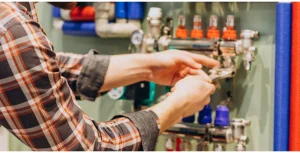Troubleshooting commercial hydronic pumps in urban settings presents distinct challenges. High-density construction often leads to varying water quality, impacting pump efficiency. Regular inspections and diagnostic tools, such as pressure gauges, are essential for identifying common issues like cavitation and sediment buildup. Additionally, understanding the influence of urban infrastructure on pump performance is imperative. Effective strategies and maintenance practices can greatly enhance operational reliability. However, these complexities demand a more thorough exploration of effective techniques.
Key Takeaways
- Regularly inspect for leaks, air pockets, and blockages to ensure optimal pump performance in urban settings.
- Utilize diagnostic tools like pressure gauges to monitor fluctuations in water quality and pressure.
- Follow structured maintenance schedules to address wear and tear, ensuring reliability in densely populated areas.
- Implement data analytics to identify performance anomalies and adjust operational parameters as needed.
- Prioritize personal protective equipment (PPE) and adhere to safety protocols during troubleshooting to mitigate risks.
Common Issues With Commercial Hydronic Pumps in Urban Environments
In urban environments, commercial hydronic pumps frequently encounter several common issues that can hinder their performance and efficiency. One prevalent problem is cavitation, which occurs when vapor bubbles form in the pump due to low pressure, leading to damage. In addition, sediment buildup in the system can obstruct flow, causing overheating and decreased efficiency. Mechanical wear and tear from high operating demands may also result in leaks or component failure. Moreover, an inconsistent power supply can lead to erratic pump operation, exacerbating existing issues. For those troubleshooting commercial hydronic pumps, it’s also important to consider whether improper sizing or installation is contributing to inadequate system performance. Identifying these common issues is essential for effective troubleshooting, ensuring optimal operation in demanding urban settings.
Effective Techniques for Troubleshooting Commercial Hydronic Pumps
Troubleshooting commercial hydronic pumps requires a systematic approach to identify and resolve performance issues effectively. Technicians should begin by examining the pump’s specifications and operational parameters to establish baseline performance. Regularly checking the system for leaks, air pockets, and blockages is essential, as these factors can notably impede efficiency. Utilizing diagnostic tools, such as pressure gauges and flow meters, allows for precise monitoring of system performance. Additionally, evaluating the motor and electrical connections guarantees that power supply issues are addressed. Implementing a structured maintenance schedule can prevent many common malfunctions. By systematically analyzing each component and leveraging diagnostic equipment, technicians can enhance the reliability and longevity of commercial hydronic pumps, fostering a sense of shared responsibility within the maintenance team.
The Impact of Urban Infrastructure on Hydronic Pump Performance
While urban infrastructure offers essential support for commercial hydronic systems, it can also present unique challenges that affect pump performance. Factors such as high-density construction and limited space can restrict airflow and access to maintenance, leading to inefficiencies. Additionally, fluctuating water quality and pressure variations in urban settings may strain pump operations, causing premature wear or failure. Noise pollution from surrounding environments can complicate troubleshooting commercial hydronic pumps, as it obscures operational sounds indicative of malfunction. Moreover, the integration of smart technologies and sensors in urban infrastructure requires careful calibration to maintain peak pump functionality. Addressing these challenges necessitates a thorough understanding of the urban landscape and its impact on hydronic systems to guarantee reliable performance and longevity.
Safety Considerations During Troubleshooting of Hydronic Pumps
Ensuring safety during the troubleshooting of commercial hydronic pumps is paramount, as various hazards can arise from the system’s operation and environment. Technicians must prioritize personal protective equipment (PPE), including gloves, goggles, and appropriate footwear, to mitigate risks associated with high-pressure systems and hot surfaces. Proper lockout/tagout procedures should be strictly followed to prevent accidental start-up while maintenance is conducted. Awareness of potential electrical hazards is critical; ensuring circuits are de-energized before inspection can prevent severe injury. Additionally, technicians should be mindful of fluid leaks and spills, implementing containment measures to avoid slips and environmental contamination. By adhering to these safety considerations, technicians can create a safer work environment while effectively troubleshooting commercial hydronic pumps.
Best Practices for Maintaining Commercial Hydronic Pumps in Urban Settings
Maintaining commercial hydronic pumps in urban settings requires a systematic approach to confirm peak performance and longevity. Consistent care guarantees reliable operation, especially in densely populated areas where environmental factors can impact system efficiency.
Best practices include:
- Regular Inspections: Conduct frequent checks to identify wear and tear before they escalates into major issues.
- Cleanliness: Keep the pump and surrounding areas free of debris to prevent obstruction and overheating.
- Monitoring Performance: Utilize data analytics to track performance metrics and identify anomalies promptly.
- Scheduled Maintenance: Implement a routine maintenance schedule to replace seals, lubricate components, and flush systems as needed.
Frequently Asked Questions
How Do I Choose the Right Hydronic Pump for My Building?
Choosing the right hydronic pump requires evaluating building specifications, flow requirements, and pressure needs. Analyzing energy efficiency and compatibility with existing systems guarantees peak performance, ultimately enhancing climate control and energy management within the facility.
What Are the Signs of a Failing Hydronic Pump?
Signs of a failing hydronic pump include unusual noises, fluctuating pressure, reduced flow rates, increased energy consumption, and visible leaks. Identifying these indicators early aids in effective troubleshooting, ensuring system efficiency and longevity.
Can I Troubleshoot My Hydronic Pump Without Professional Help?
Troubleshooting a hydronic pump independently is feasible, provided the individual possesses adequate technical knowledge. Key indicators of issues should be identified, but complex problems may still require professional assistance for thorough resolution and safety assurance.
How Often Should Commercial Hydronic Pumps Be Serviced?
Commercial hydronic pumps should typically be serviced annually to guarantee peak performance and longevity. Regular maintenance helps identify potential issues early, minimizing downtime and enhancing efficiency, which is vital for effective system operation in various environments.
What Tools Do I Need for Troubleshooting Hydronic Pumps?
To effectively troubleshoot hydronic pumps, essential tools include a multimeter for electrical diagnostics, pressure gauges for system assessment, wrenches for mechanical adjustments, and a thermal camera to identify temperature variations indicative of issues.
Conclusion
To sum up, troubleshooting commercial hydronic pumps in urban settings requires a systematic approach that accounts for the unique challenges posed by high-density construction and variable water quality. By employing effective diagnostic techniques, adhering to safety protocols, and implementing a robust maintenance schedule, facility managers can enhance pump performance and reliability. Utilizing data analytics further supports proactive measures, ensuring that hydronic systems operate efficiently, ultimately contributing to the sustainability of urban infrastructure.
You May Also Like:








